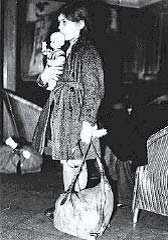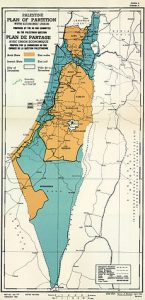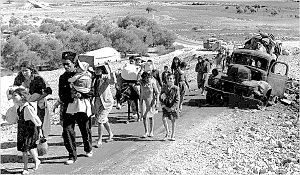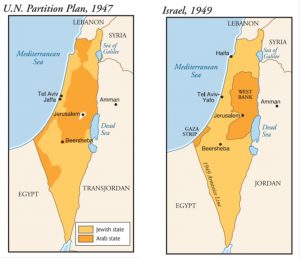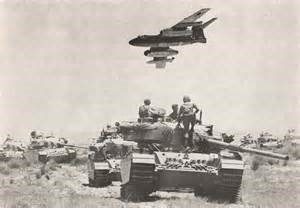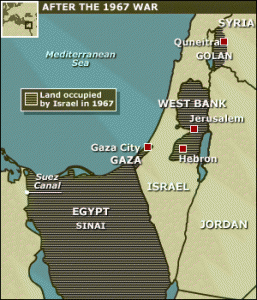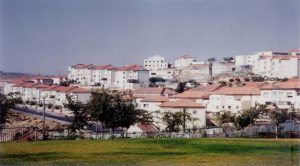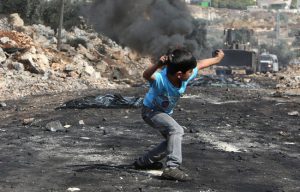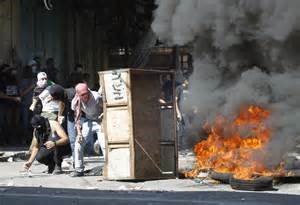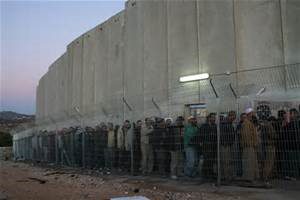Focus: Universal Declaration of Human Rights
Article 19: Everyone has the right to a nationality
Value: Wisdom
The boundaries of Israel and the occupied Palestinian territory have changed a lot since 1948.
Learning Intention: I will learn about the land Israel had in 1948 and today.
I will learn about the land the Palestinians had in 1948 and today.
Success Criteria: I can give reasons why Israel has the land it has. I can give reasons why Palestinians have the land they have.
Activity 1
1. In groups, read the information on the cards, answer the questions.
Event Cards
| At the end of the 19th century, the Zionist movement, recognising Jewish people were vulnerable to persecution in Europe, encouraged migration to Palestine to help form a Jewish state. | In 1917 Britain stated, in the Balfour Declaration, that they would support a homeland for Jewish people. |
|
In the Holocaust, 11 million people were killed by the Nazis including 6 million Jews, disabled people, Slavs, Poles, Roma, homosexuals and trade unionists . Many Jewish survivors of the Holocaust moved to Palestine after World War 2.
|
After World War 2, the United Nations recommended creation of independent Jewish and Arab states in Palestine. 55% was to be a Jewish state with 45% for the Palestinians.
|
|
In 1948 the State of Israel was proclaimed by Israel and recognised by the UN. 750,000 Palestinians fled from their homes.
|
As a result of the Arab/Israeli war of 1948, the State of Israel had a larger percentage of the land than originally agreed. The UN Partition Plan had allocated 56% of the land to Israel and 44% of the land to Palestine. By the end of the Arab/Israeli war, Israel held 78% of the land with 22% in Palestinian hands.
|
|
The 1967 ‘Six Day War’ arose from tensions between Israel and its neighbours. During the war Israel occupied Gaza and the West Bank including East Jerusalem.
|
Soon after the Six-Day War Israel started to build settlements in the West Bank and Gaza. These settlements were declared illegal in 2004 by the International Court of Justice.
|
|
In the first Intifada, or uprising, in 1987, Palestinians protested against Israeli occupation by throwing stones at the Israeli army, who responded with force.
|
Palestinians protested again in the second Intifada in 2000. This was a time of increased violence, including terrorist attacks against Israeli civilians.
|
|
Since the beginning of the 21st century, Israel has been building a barrier with checkpoints. They believe that this barrier will keep their citizens safe from Palestinian attack.
|
Despite many attempts to bring about peace between Israel and the occupied Palestinian territory, there is no end to the conflict in sight.
|
| On 30 March 2018, protests known under the banner “Great March of Return and Breaking of the Siege” began. The protests entailed weekly demonstrations by Palestinians near the fence that since 1996 has separated Gaza and Israel, demanding that the blockade imposed on Gaza be lifted and the return of Palestinian refugees to their original homes. |
|
Event Questions
- Look up the meaning of the words in the event cards that are underlined.
- Why was the Zionist movement formed? The Zionist movement was formed because ………………………..
- What did the Balfour Declaration state? The Balfour Declaration stated …………………….
- How many Jewish and non-Jewish people died in the Holocaust? ………… Jewish people and …………. Non-Jewish people died in the holocaust.
- What percentage of Palestine did the UN recommend for a Jewish state and an Arab state? The UN recommended …………………….. % of Palestine for a Jewish state and ………………… % for an Arab state.
- When was the State of Israel proclaimed? The State of Israel was created in ………………
- How many Palestinians were forced to leave their homes in 1948? …………………………… fled from their home in 1948.
- Did the State of Israel have more or less land after 1967? Israel had ……………………. land after 1967.
- What did the International Court of Justice (ICJ) say about the settlements? The ICJ said ……………………………………
- How did Palestinians respond in the first Intifada? During the first Intifada the Palestinians …………………………………….
- What was different in the second Intifada? The second Intifada was different because ………………………………………..
- Why have the Israelis been building a barrier between them and their Palestinian neighbours? The Israeli have built a barrier because …………………………
- What do Palestinians hope to gain from The Great March of Return? The Palestinians hope to gain ………………………………………..

